
Svante August Arrhenius 1859 - 1927
Svante August Arrhenius was born in 1859 in Wijk, Uppsala, Sweden. He studied at the universities of Uppsala and Stockholm, writing his doctoral thesis on the electrical conductivity of solutions. This thesis - which proposed that molecules split into electrically charged ‘ions’ in solution - contradicted the dominant understanding and as a result was judged harshly by his examiners. It was only narrowly accepted, despite the fact that it became the basis of the ionic theory of electrolytes.
Arrhenius sent his thesis to several of the leading physical chemists of the time, including Jacobus van’t Hoff and Wilhelm Ostwald, who were impressed with his work. Arrhenius secured a travel grant and worked in laboratories in Riga, Würzburg, Graz and Amsterdam, continuing his work on ionic theory.
Arrhenius’s reputation grew, though it was not until the discovery of the electron - an electrically charged subatomic particle - in the 1890s that his ionic theory became widely accepted by his peers. Arrhenius was awarded a Nobel Prize in 1903 and became the Director of the Nobel Institute of Physical Chemistry in Stockholm two years later.
For many years Arrhenius was best known for his contributions to the ionic theory and the theory of chemical kinetics (the Arrhenius equation which shows the effect of temperature on the rate of reaction), but recently he has become celebrated for his pioneering work on the ‘greenhouse effect’.
Seeking to explain the ice ages, he calculated the impact of carbon dioxide in the atmosphere on the Earth’s temperature. Working with his colleague Arvid Högbom, Arrhenius demonstrated that a doubling of atmospheric carbon dioxide would lead to a 5-6 °C increase in global temperature. However, fearing a new ice age, Arrhenius and Högbom welcomed the potential global warming they thus predicted.
Arrhenius died in Stockholm in 1927.